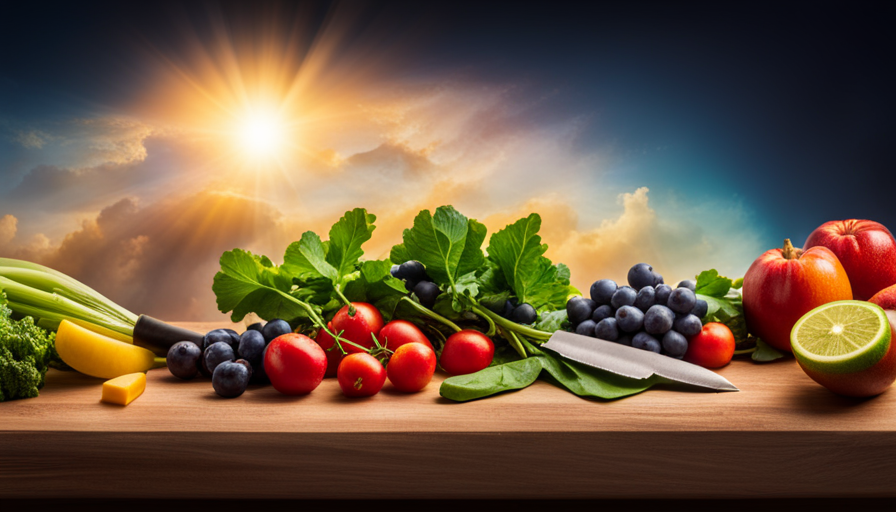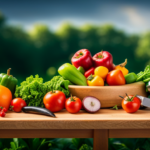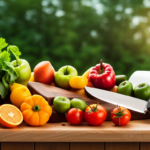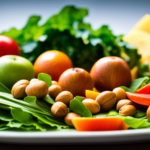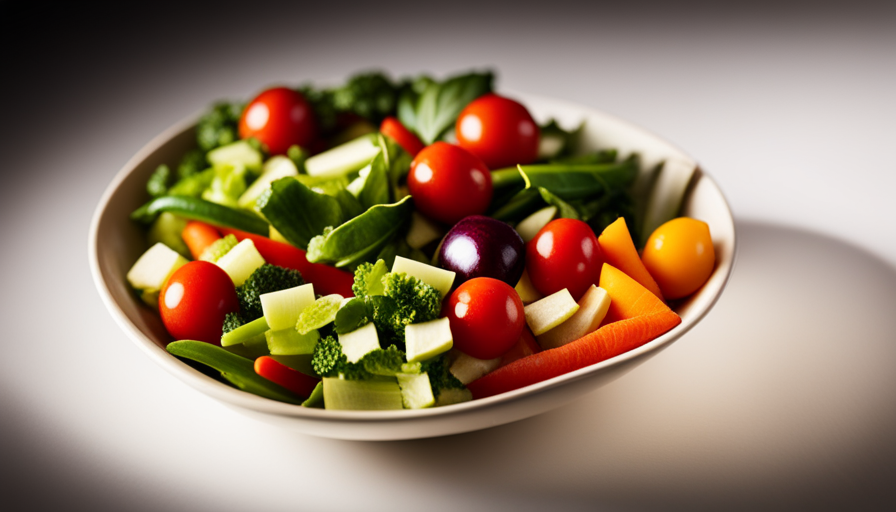Are you unsure about trying a raw food diet? You might be asking yourself, ‘Why would I want to eat food that hasn’t been cooked?’
Well, let me tell you, preparing a raw food diet can be a game-changer for your health and well-being. Contrary to popular belief, raw food isn’t just about munching on plain fruits and vegetables. It’s about harnessing the power of natural, nutrient-dense ingredients to nourish your body from the inside out.
In this article, we will guide you through the process of preparing a raw food diet, step by step. From understanding the benefits of this lifestyle to exploring different recipes and managing nutritional needs, we’ve got you covered.
With the right tools, knowledge, and motivation, you can easily incorporate a raw food diet into your daily routine and experience the incredible benefits it has to offer. Let’s get started on this journey towards vibrant health and vitality!
Key Takeaways
- Transitioning to a raw food lifestyle may have challenges, such as cravings and social aspects.
- High-speed blender, food processor, and spiralizer are essential tools for raw food preparation.
- Choosing high-quality ingredients is crucial for taste and nutrition.
- Proper food storage and preservation techniques are important for maintaining freshness and preventing spoilage.
Understanding the Benefits of a Raw Food Diet
You’ll be amazed at the vibrant colors and fresh flavors that come with a raw food diet, as you bite into juicy fruits and crisp vegetables straight from nature’s garden. But there’s more to it than just taste. Understanding the science behind raw food can help you appreciate the numerous benefits it offers.
Raw food enthusiasts believe that cooking destroys vital enzymes and nutrients, leading to poor digestion and nutrient deficiencies. However, research suggests that while cooking does reduce some nutrient levels, it also enhances the bioavailability of others. For example, cooking tomatoes actually increases the absorption of lycopene, a powerful antioxidant. So, don’t be afraid to enjoy a cooked meal every now and then.
Debunking common myths about raw food is essential to make informed decisions. One common misconception is that raw food automatically means a vegan diet. While many raw foodists do follow a vegan lifestyle, it’s not a requirement. Raw food can include animal products like raw fish or unpasteurized dairy. It’s all about personal preference and finding what works for you.
Understanding the science behind raw food and debunking common myths can help you make informed choices about your diet. Incorporating raw fruits and vegetables into your meals can certainly enhance their taste and nutritional value, but it’s important to strike a balance and not completely eliminate cooked foods from your diet.
Transitioning to a Raw Food Lifestyle
Once you start incorporating fresh fruits and vegetables into your meals, you’ll notice a vibrant change in your lifestyle. Transitioning to a raw food lifestyle can have numerous benefits for your health and well-being. However, it’s important to be aware of the challenges that may arise during this process and find ways to maintain your motivation.
One of the main challenges when transitioning to a raw food lifestyle is dealing with cravings for cooked and processed foods. It’s natural to have these cravings, especially if you’ve been eating a certain way for a long time. To overcome this challenge, it can be helpful to gradually incorporate more raw foods into your diet and slowly eliminate cooked and processed foods. This way, your taste buds have time to adjust, and you’re less likely to feel deprived.
Another challenge is the social aspect of eating a raw food diet. It can be challenging to find restaurants or social gatherings that offer raw food options. To overcome this, you can plan ahead and bring your own raw food dishes to social events or choose restaurants that offer raw food options. Additionally, finding a community of like-minded individuals who also follow a raw food lifestyle can provide support and motivation.
Maintaining motivation is crucial when transitioning to a raw food lifestyle. It’s important to remind yourself of the reasons why you chose to follow this diet, whether it’s for health reasons or ethical considerations. Setting short-term and long-term goals can also help you stay motivated. Celebrate each small achievement and focus on the positive changes you’re experiencing in your health and overall well-being.
Transitioning to a raw food lifestyle may have its challenges, but with determination and support, you can successfully make the switch. Stay motivated, be patient with yourself, and enjoy the vibrant and nourishing benefits of a raw food diet.
Essential Tools and Equipment for Raw Food Preparation
Get ready to enhance your raw culinary skills with these must-have tools and equipment for effortlessly creating delicious and nutritious meals. When it comes to preparing a raw food diet, having the right tools can make all the difference in the world. Here are some essential raw food preparation tools and must-have equipment that will help you on your journey to a healthier lifestyle.
| Tools | Equipment |
|---|---|
| High-speed blender | Dehydrator |
| Food processor | Spiralizer |
| Nut milk bag | Mandoline slicer |
| Julienne peeler | Sprouting jars or trays |
A high-speed blender is a game-changer in the raw food world. It can easily blend fruits, vegetables, and nuts into creamy sauces, smoothies, and dressings. A food processor is another essential tool for chopping, shredding, and pureeing ingredients. It’s perfect for making raw desserts, nut butters, and dips.
To add variety to your meals, a spiralizer is a must-have. It can turn vegetables like zucchini and carrots into noodle-like strands, allowing you to create raw pasta dishes or vibrant salads. A mandoline slicer is great for achieving thin and uniform slices of fruits and vegetables.
If you enjoy making your own nut milk, a nut milk bag is a crucial tool. It helps you strain out the pulp, resulting in smooth and creamy homemade nut milk. Lastly, sprouting jars or trays are essential for growing your own sprouts, adding a fresh and nutritious touch to salads and sandwiches.
Investing in these raw food preparation tools and must-have equipment will make your journey to a raw food lifestyle more enjoyable and convenient.
Choosing High-Quality Ingredients for Your Raw Meals
When creating vibrant and nutritious raw meals, it’s crucial to select high-quality ingredients that’ll elevate your culinary creations. By choosing high-quality ingredients, you not only ensure the best taste and texture but also maximize the nutritional value of your meals. Here are some tips on selecting the best ingredients for your raw food diet:
-
High-Quality Protein Sources:
-
Incorporate nuts and seeds like almonds, walnuts, and chia seeds into your meals. They’re rich in essential fatty acids and provide a good amount of protein.
-
Include legumes such as lentils, chickpeas, and black beans. They’re a great source of plant-based protein and offer a variety of flavors and textures.
-
Opt for sprouts like alfalfa, broccoli, and mung bean sprouts. They’re not only rich in protein but also packed with enzymes and nutrients.
-
Sourcing Organic Produce:
-
Choose organic fruits and vegetables whenever possible. They’re grown without synthetic pesticides and fertilizers, ensuring a higher nutrient content and better taste.
-
Visit local farmers’ markets or join a community-supported agriculture (CSA) program to access fresh, organic produce directly from local farmers.
-
Consider growing your own organic produce in a small garden or even on your windowsill. This way, you have complete control over the quality of the ingredients you use.
By following these guidelines and incorporating high-quality protein sources and organic produce, you can create delicious and nutrient-dense raw meals that support your health and well-being.
Exploring Different Raw Food Recipes
Delving into a world of culinary creativity, you’ll discover a plethora of tantalizing raw recipes that will excite your taste buds and nourish your body. Raw food dessert recipes offer a guilt-free indulgence, allowing you to satisfy your sweet tooth without compromising your health. From raw vegan cheesecakes to chocolate avocado mousse, these desserts are not only delicious but also packed with nutrients. They often feature ingredients like dates, nuts, and cacao powder, providing a rich source of antioxidants, healthy fats, and fiber.
When it comes to raw food meal planning, it’s important to have a variety of recipes that cater to your taste preferences and nutritional needs. To help you get started, here’s a sample meal plan for a day of raw eating:
| Breakfast | Lunch | Dinner | Snack |
|---|---|---|---|
| Green smoothie | Zucchini noodles with pesto | Raw tacos with walnut meat | Fresh fruit salad |
This meal plan incorporates a balance of fruits, vegetables, nuts, and seeds, ensuring you receive a wide array of vitamins, minerals, and phytonutrients. By experimenting with different raw food recipes, you can create delicious, satisfying meals while reaping the benefits of a raw food diet. So, grab your blender, spiralizer, and dehydrator, and embark on a culinary journey that will nourish your body and delight your taste buds.
Incorporating Superfoods into Your Raw Food Diet
To truly elevate your raw culinary creations, infuse your meals with the power of superfoods, transforming them into nutrient-packed masterpieces. Superfoods are a great addition to any raw food diet as they’re rich in vitamins, minerals, and antioxidants that can support your overall health. If you’re looking to shed a few pounds, incorporating superfoods for weight loss can be a game-changer.
One easy way to incorporate superfoods into your raw food diet is by adding them to your smoothies. Smoothies are a delicious and convenient way to pack a punch of nutrients into your diet. Start by choosing a base like coconut water or almond milk, and then add in a handful of leafy greens like kale or spinach. To boost the nutritional value even further, toss in some superfoods like chia seeds, hemp hearts, or goji berries. These superfoods aren’t just low in calories but also high in fiber, which can help you feel full and satisfied.
Incorporating superfoods into your raw food diet can take your meals to the next level. By including superfoods for weight loss and incorporating them into smoothies, you can enjoy nutrient-dense and delicious meals that support your health goals. So, go ahead and experiment with different superfoods to find the perfect combination that works for you.
Proper Food Storage and Preservation Techniques
Now that you’ve learned about incorporating superfoods into your raw food diet, let’s delve into the crucial topic of proper food storage and preservation techniques. Ensuring food safety and preventing food spoilage are essential aspects of maintaining a healthy raw food diet.
When it comes to storing your raw food, it’s important to keep in mind that raw ingredients are more vulnerable to spoilage than cooked ones. To maintain freshness and prevent bacterial growth, it’s imperative to store your fruits, vegetables, and nuts properly. Store them in airtight containers or sealable bags in the refrigerator to maintain their crispness and prevent them from drying out.
Moreover, it’s crucial to adhere to food safety guidelines to avoid any potential health risks. Wash your fruits and vegetables thoroughly before consumption to remove any dirt or bacteria that may be present. Additionally, be mindful of cross-contamination by keeping raw ingredients separate from cooked or ready-to-eat foods.
To extend the shelf life of your raw food, consider utilizing preservation techniques such as freezing or dehydrating. Freezing helps retain the nutritional value of your ingredients, while dehydrating can provide delicious snacks that are easy to store and carry.
By following these proper food storage and preservation techniques, you can ensure the safety and longevity of your raw food diet. Remember, a little extra effort in storing your raw ingredients can go a long way in maintaining their freshness and maximizing their health benefits.
Managing Nutritional Needs on a Raw Food Diet
Taking care of your body’s nutritional needs is essential when following a raw food lifestyle, ensuring you feel energized and nourished. Managing digestive issues is crucial for maintaining optimal health on a raw food diet.
Raw foods are rich in fiber, which aids digestion, but some individuals may experience bloating or gas initially. To alleviate these symptoms, gradually introduce raw foods into your diet and chew them thoroughly to enhance digestion. Additionally, incorporating probiotic-rich foods like sauerkraut or coconut yogurt can promote a healthy gut microbiome and improve digestion.
If you’re an athlete, adapting a raw food diet to meet your increased nutritional needs is important. Raw foods provide essential nutrients for physical activity, but you may need to consume larger quantities to meet your energy demands. Focus on incorporating calorie-dense raw foods such as nuts, seeds, avocados, and coconut into your meals. Additionally, ensure you’re getting enough protein by consuming plant-based sources like hemp seeds, spirulina, and lentils.
It’s also important to monitor your nutrient intake as an athlete on a raw food diet. Consider consulting with a registered dietitian or nutritionist to ensure you’re meeting your specific nutrient requirements. They can help you optimize your diet by suggesting appropriate food combinations and supplement options if necessary.
By managing digestive issues and adapting your raw food diet for your athletic needs, you can successfully nourish your body and thrive on a raw food lifestyle.
Overcoming Challenges and Staying Motivated
Overcoming challenges and staying motivated can be difficult when following a raw food lifestyle, but studies have shown that individuals who join support groups are 60% more likely to stick to their dietary goals.
It’s no secret that maintaining a raw food diet can be tough at times. Temptations from processed foods and the convenience of fast food can make it easy to slip up. That’s why finding ways to stay motivated and overcome obstacles is crucial for long-term success.
One effective strategy for staying motivated is to set small, achievable goals. Breaking your overall dietary goal into smaller milestones can help you stay focused and motivated. Celebrate these milestones along the way to keep the momentum going.
Another important aspect of staying motivated is surrounding yourself with like-minded individuals. Joining a raw food support group or finding an online community can provide you with the support and encouragement you need to stay on track. Sharing your challenges and successes with others who understand can be incredibly empowering.
When faced with obstacles, it’s important to have a plan in place to overcome them. For example, if you find it difficult to resist cravings for unhealthy foods, try finding healthy alternatives that satisfy your cravings. Experiment with new recipes and flavors to keep things interesting and prevent boredom.
Remember, staying motivated and overcoming obstacles is a journey. Be kind to yourself and celebrate your progress along the way. With the right support and mindset, you can successfully navigate the challenges of a raw food diet and achieve your health goals.
Seeking Professional Guidance for a Raw Food Lifestyle
Seeking the guidance of a professional can be a transformative experience that propels you towards achieving optimal health and vitality on your raw food journey. With the abundance of raw food misconceptions out there, it’s crucial to consult with someone who has expertise in this lifestyle.
A professional can provide you with accurate information, debunk myths, and help you navigate any challenges that may arise. A qualified professional will have a deep understanding of the raw food diet and its potential benefits. They can help you create a well-balanced meal plan that meets your nutritional needs and supports your goals. They can also guide you in sourcing high-quality ingredients and offer tips on food preparation techniques to maximize nutrient retention.
Additionally, seeking professional guidance can help you overcome any doubts or skepticism you may have about the raw food lifestyle. They can provide evidence-based information and scientific studies that support the health benefits of a raw food diet. This knowledge can reinforce your motivation and keep you on track when faced with societal pressures or negative opinions.
Remember, everyone’s journey is unique, and what works for one person may not work for another. By seeking professional guidance, you can tailor your raw food lifestyle to suit your individual needs and goals, ensuring long-term success and optimal health.
Frequently Asked Questions
Can I still eat cooked food occasionally while following a raw food diet?
Yes, you can still enjoy cooked food occasionally while following a raw food diet. It’s all about balance and making exceptions. While raw food is packed with enzymes and nutrients, occasional cooked food can provide comfort and variety. However, keep in mind that cooking can destroy some nutrients and enzymes. So, it’s best to opt for healthier cooking methods like steaming or baking. Remember, the key is moderation and prioritizing the benefits of both raw and cooked foods.
How can I ensure I am getting enough protein on a raw food diet?
To ensure you’re getting enough protein on a raw food diet, focus on incorporating plant-based protein sources such as nuts, seeds, legumes, and leafy greens into your meals. These foods are rich in essential amino acids and can help meet your protein needs.
Additionally, consider including fermented foods like tempeh or miso, which can enhance protein absorption.
Remember, a well-balanced raw food diet can support weight loss while providing adequate protein intake.
Are there any specific foods I should avoid on a raw food diet?
To ensure a healthy raw food diet, there are certain foods you should avoid to minimize potential health risks. Raw meat and seafood should be avoided due to the risk of bacterial contamination. Raw eggs can also pose a salmonella risk. Additionally, unpasteurized dairy products may contain harmful bacteria. It’s important to steer clear of raw sprouts, as they are prone to bacterial contamination. By avoiding these foods, you can ensure a safer raw food diet.
Can I still consume dairy products on a raw food diet?
While dancing to the beat of a healthy lifestyle, ditching dairy products on a raw food diet can be beneficial. Opt for dairy alternatives like almond milk, coconut yogurt, or cashew cheese to satisfy your cravings.
Embracing a raw food diet can enhance your well-being by providing essential nutrients, promoting weight loss, and improving digestion. So, go ahead and explore the world of dairy-free delights on your raw food journey!
How can I maintain a balanced diet and ensure I am getting all the necessary nutrients on a raw food diet?
To maintain a balanced diet on a raw food diet, it’s important to ensure you’re getting all the necessary nutrients. Focus on consuming a variety of fruits, vegetables, nuts, and seeds to cover your nutritional needs. Include sources of protein like legumes and sprouted grains.
To ensure adequate nutrient intake, consider adding supplements like vitamin B12, iron, and omega-3 fatty acids. It’s also crucial to listen to your body and make adjustments as needed.
Can increasing absorption in a raw food diet affect the preparation process?
Increasing absorption in raw food is vital for optimal health. The preparation process can impact absorption levels. Properly preparing raw foods through soaking, sprouting, or blending can break down nutrients, making them easier for the body to absorb. These steps can enhance the nutritional benefits of a raw food diet.
Conclusion
In conclusion, you now have the knowledge and tools to embark on a raw food journey that’ll bring you closer to optimal health.
Just like a seed needs nurturing to grow into a beautiful flower, your commitment to a raw food diet will nurture your body and soul.
Remember, Rome wasn’t built in a day, so take it one step at a time and don’t be discouraged by challenges along the way.
Seek the guidance of professionals to help you stay motivated and ensure you’re meeting your nutritional needs.
Embrace this new lifestyle and watch yourself bloom into a healthier, happier you.

